Xing Wei
VGAT: A Cancer Survival Analysis Framework Transitioning from Generative Visual Question Answering to Genomic Reconstruction
Mar 25, 2025Abstract:Multimodal learning combining pathology images and genomic sequences enhances cancer survival analysis but faces clinical implementation barriers due to limited access to genomic sequencing in under-resourced regions. To enable survival prediction using only whole-slide images (WSI), we propose the Visual-Genomic Answering-Guided Transformer (VGAT), a framework integrating Visual Question Answering (VQA) techniques for genomic modality reconstruction. By adapting VQA's text feature extraction approach, we derive stable genomic representations that circumvent dimensionality challenges in raw genomic data. Simultaneously, a cluster-based visual prompt module selectively enhances discriminative WSI patches, addressing noise from unfiltered image regions. Evaluated across five TCGA datasets, VGAT outperforms existing WSI-only methods, demonstrating the viability of genomic-informed inference without sequencing. This approach bridges multimodal research and clinical feasibility in resource-constrained settings. The code link is https://github.com/CZZZZZZZZZZZZZZZZZ/VGAT.
Semantic Segmentation Prior for Diffusion-Based Real-World Super-Resolution
Dec 04, 2024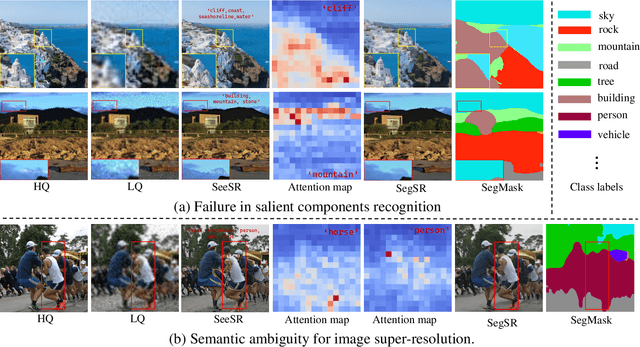
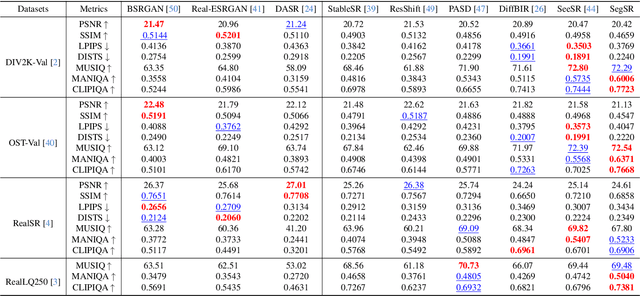
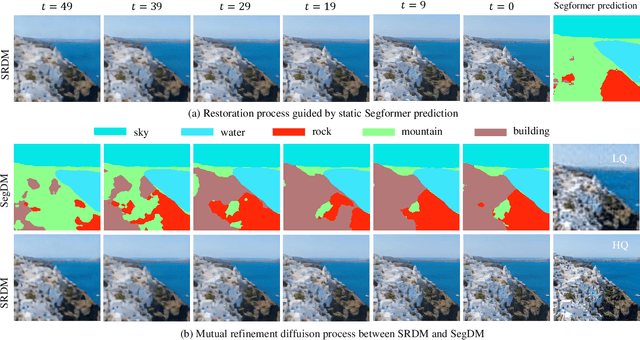

Abstract:Real-world image super-resolution (Real-ISR) has achieved a remarkable leap by leveraging large-scale text-to-image models, enabling realistic image restoration from given recognition textual prompts. However, these methods sometimes fail to recognize some salient objects, resulting in inaccurate semantic restoration in these regions. Additionally, the same region may have a strong response to more than one prompt and it will lead to semantic ambiguity for image super-resolution. To alleviate the above two issues, in this paper, we propose to consider semantic segmentation as an additional control condition into diffusion-based image super-resolution. Compared to textual prompt conditions, semantic segmentation enables a more comprehensive perception of salient objects within an image by assigning class labels to each pixel. It also mitigates the risks of semantic ambiguities by explicitly allocating objects to their respective spatial regions. In practice, inspired by the fact that image super-resolution and segmentation can benefit each other, we propose SegSR which introduces a dual-diffusion framework to facilitate interaction between the image super-resolution and segmentation diffusion models. Specifically, we develop a Dual-Modality Bridge module to enable updated information flow between these two diffusion models, achieving mutual benefit during the reverse diffusion process. Extensive experiments show that SegSR can generate realistic images while preserving semantic structures more effectively.
FLAME: Frozen Large Language Models Enable Data-Efficient Language-Image Pre-training
Nov 18, 2024Abstract:Language-image pre-training faces significant challenges due to limited data in specific formats and the constrained capacities of text encoders. While prevailing methods attempt to address these issues through data augmentation and architecture modifications, they continue to struggle with processing long-form text inputs, and the inherent limitations of traditional CLIP text encoders lead to suboptimal downstream generalization. In this paper, we propose FLAME (Frozen Large lAnguage Models Enable data-efficient language-image pre-training) that leverages frozen large language models as text encoders, naturally processing long text inputs and demonstrating impressive multilingual generalization. FLAME comprises two key components: 1) a multifaceted prompt distillation technique for extracting diverse semantic representations from long captions, which better aligns with the multifaceted nature of images, and 2) a facet-decoupled attention mechanism, complemented by an offline embedding strategy, to ensure efficient computation. Extensive empirical evaluations demonstrate FLAME's superior performance. When trained on CC3M, FLAME surpasses the previous state-of-the-art by 4.9\% in ImageNet top-1 accuracy. On YFCC15M, FLAME surpasses the WIT-400M-trained CLIP by 44.4\% in average image-to-text recall@1 across 36 languages, and by 34.6\% in text-to-image recall@1 for long-context retrieval on Urban-1k. Code is available at \url{https://github.com/MIV-XJTU/FLAME}.
Driving by the Rules: A Benchmark for Integrating Traffic Sign Regulations into Vectorized HD Map
Oct 31, 2024



Abstract:Ensuring adherence to traffic sign regulations is essential for both human and autonomous vehicle navigation. While current benchmark datasets concentrate on lane perception or basic traffic sign recognition, they often overlook the intricate task of integrating these regulations into lane operations. Addressing this gap, we introduce MapDR, a novel dataset designed for the extraction of Driving Rules from traffic signs and their association with vectorized, locally perceived HD Maps. MapDR features over 10,000 annotated video clips that capture the intricate correlation between traffic sign regulations and lanes. We define two pivotal sub-tasks: 1) Rule Extraction from Traffic Sign, which accurately deciphers regulatory instructions, and 2) Rule-Lane Correspondence Reasoning, which aligns these rules with their respective lanes. Built upon this benchmark, we provide a multimodal solution that offers a strong baseline for advancing autonomous driving technologies. It fills a critical gap in the integration of traffic sign rules, contributing to the development of reliable autonomous navigation systems.
Driving with Prior Maps: Unified Vector Prior Encoding for Autonomous Vehicle Mapping
Sep 11, 2024



Abstract:High-Definition Maps (HD maps) are essential for the precise navigation and decision-making of autonomous vehicles, yet their creation and upkeep present significant cost and timeliness challenges. The online construction of HD maps using on-board sensors has emerged as a promising solution; however, these methods can be impeded by incomplete data due to occlusions and inclement weather. This paper proposes the PriorDrive framework to addresses these limitations by harnessing the power of prior maps, significantly enhancing the robustness and accuracy of online HD map construction. Our approach integrates a variety of prior maps, such as OpenStreetMap's Standard Definition Maps (SD maps), outdated HD maps from vendors, and locally constructed maps from historical vehicle data. To effectively encode this prior information into online mapping models, we introduce a Hybrid Prior Representation (HPQuery) that standardizes the representation of diverse map elements. At the core of PriorDrive is the Unified Vector Encoder (UVE), which employs a dual encoding mechanism to process vector data. The intra-vector encoder captures fine-grained local features, while the inter-vector encoder integrates global context. Furthermore, we propose a segment-level and point-level pre-training strategy that enables the UVE to learn the prior distribution of vector data, thereby improving the encoder's generalizability and performance. Through extensive testing on the nuScenes dataset, we demonstrate that PriorDrive is highly compatible with various online mapping models and substantially improves map prediction capabilities. The integration of prior maps through the PriorDrive framework offers a robust solution to the challenges of single-perception data, paving the way for more reliable autonomous vehicle navigation.
Neural Spectral Decomposition for Dataset Distillation
Aug 29, 2024
Abstract:In this paper, we propose Neural Spectrum Decomposition, a generic decomposition framework for dataset distillation. Unlike previous methods, we consider the entire dataset as a high-dimensional observation that is low-rank across all dimensions. We aim to discover the low-rank representation of the entire dataset and perform distillation efficiently. Toward this end, we learn a set of spectrum tensors and transformation matrices, which, through simple matrix multiplication, reconstruct the data distribution. Specifically, a spectrum tensor can be mapped back to the image space by a transformation matrix, and efficient information sharing during the distillation learning process is achieved through pairwise combinations of different spectrum vectors and transformation matrices. Furthermore, we integrate a trajectory matching optimization method guided by a real distribution. Our experimental results demonstrate that our approach achieves state-of-the-art performance on benchmarks, including CIFAR10, CIFAR100, Tiny Imagenet, and ImageNet Subset. Our code are available at \url{https://github.com/slyang2021/NSD}.
Positional Prompt Tuning for Efficient 3D Representation Learning
Aug 21, 2024Abstract:Point cloud analysis has achieved significant development and is well-performed in multiple downstream tasks like point cloud classification and segmentation, etc. Being conscious of the simplicity of the position encoding structure in Transformer-based architectures, we attach importance to the position encoding as a high-dimensional part and the patch encoder to offer multi-scale information. Together with the sequential Transformer, the whole module with position encoding comprehensively constructs a multi-scale feature abstraction module that considers both the local parts from the patch and the global parts from center points as position encoding. With only a few parameters, the position embedding module fits the setting of PEFT (Parameter-Efficient Fine-Tuning) tasks pretty well. Thus we unfreeze these parameters as a fine-tuning part. At the same time, we review the existing prompt and adapter tuning methods, proposing a fresh way of prompts and synthesizing them with adapters as dynamic adjustments. Our Proposed method of PEFT tasks, namely PPT, with only 1.05% of parameters for training, gets state-of-the-art results in several mainstream datasets, such as 95.01% accuracy in the ScanObjectNN OBJ_BG dataset. Codes will be released at https://github.com/zsc000722/PPT.
Projecting Points to Axes: Oriented Object Detection via Point-Axis Representation
Jul 11, 2024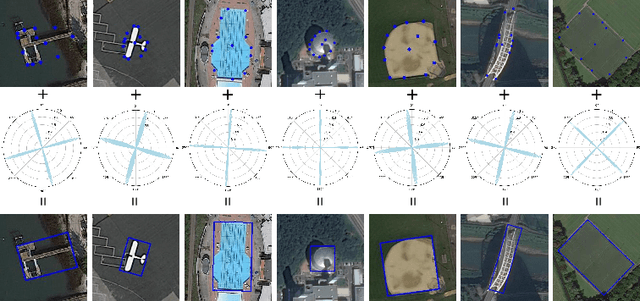

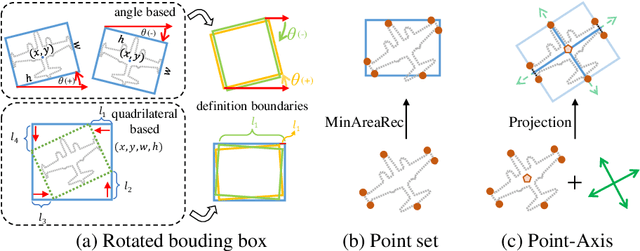
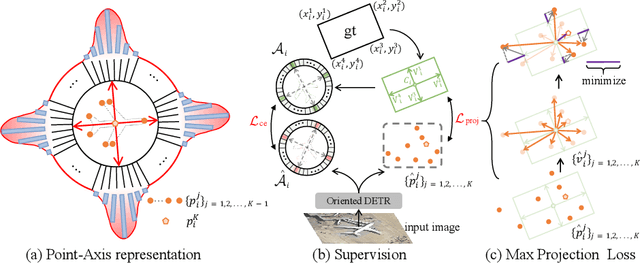
Abstract:This paper introduces the point-axis representation for oriented object detection, emphasizing its flexibility and geometrically intuitive nature with two key components: points and axes. 1) Points delineate the spatial extent and contours of objects, providing detailed shape descriptions. 2) Axes define the primary directionalities of objects, providing essential orientation cues crucial for precise detection. The point-axis representation decouples location and rotation, addressing the loss discontinuity issues commonly encountered in traditional bounding box-based approaches. For effective optimization without introducing additional annotations, we propose the max-projection loss to supervise point set learning and the cross-axis loss for robust axis representation learning. Further, leveraging this representation, we present the Oriented DETR model, seamlessly integrating the DETR framework for precise point-axis prediction and end-to-end detection. Experimental results demonstrate significant performance improvements in oriented object detection tasks.
Is a 3D-Tokenized LLM the Key to Reliable Autonomous Driving?
May 28, 2024Abstract:Rapid advancements in Autonomous Driving (AD) tasks turned a significant shift toward end-to-end fashion, particularly in the utilization of vision-language models (VLMs) that integrate robust logical reasoning and cognitive abilities to enable comprehensive end-to-end planning. However, these VLM-based approaches tend to integrate 2D vision tokenizers and a large language model (LLM) for ego-car planning, which lack 3D geometric priors as a cornerstone of reliable planning. Naturally, this observation raises a critical concern: Can a 2D-tokenized LLM accurately perceive the 3D environment? Our evaluation of current VLM-based methods across 3D object detection, vectorized map construction, and environmental caption suggests that the answer is, unfortunately, NO. In other words, 2D-tokenized LLM fails to provide reliable autonomous driving. In response, we introduce DETR-style 3D perceptrons as 3D tokenizers, which connect LLM with a one-layer linear projector. This simple yet elegant strategy, termed Atlas, harnesses the inherent priors of the 3D physical world, enabling it to simultaneously process high-resolution multi-view images and employ spatiotemporal modeling. Despite its simplicity, Atlas demonstrates superior performance in both 3D detection and ego planning tasks on nuScenes dataset, proving that 3D-tokenized LLM is the key to reliable autonomous driving. The code and datasets will be released.
Curriculum Dataset Distillation
May 15, 2024



Abstract:Most dataset distillation methods struggle to accommodate large-scale datasets due to their substantial computational and memory requirements. In this paper, we present a curriculum-based dataset distillation framework designed to harmonize scalability with efficiency. This framework strategically distills synthetic images, adhering to a curriculum that transitions from simple to complex. By incorporating curriculum evaluation, we address the issue of previous methods generating images that tend to be homogeneous and simplistic, doing so at a manageable computational cost. Furthermore, we introduce adversarial optimization towards synthetic images to further improve their representativeness and safeguard against their overfitting to the neural network involved in distilling. This enhances the generalization capability of the distilled images across various neural network architectures and also increases their robustness to noise. Extensive experiments demonstrate that our framework sets new benchmarks in large-scale dataset distillation, achieving substantial improvements of 11.1\% on Tiny-ImageNet, 9.0\% on ImageNet-1K, and 7.3\% on ImageNet-21K. The source code will be released to the community.
 Add to Chrome
Add to Chrome Add to Firefox
Add to Firefox Add to Edge
Add to Edge